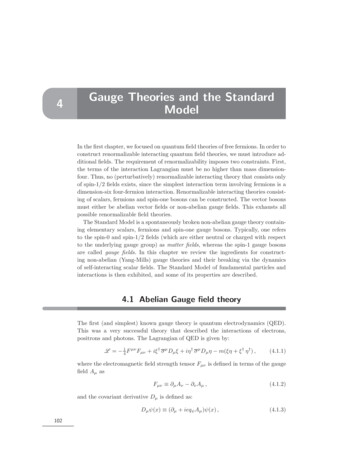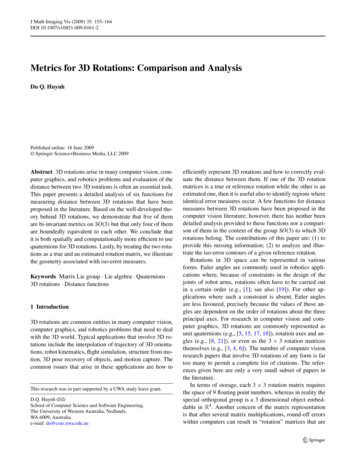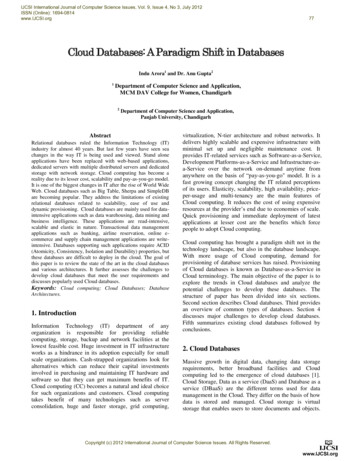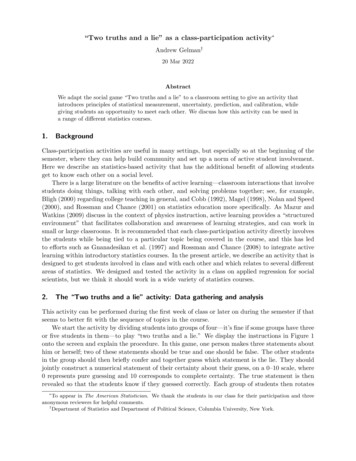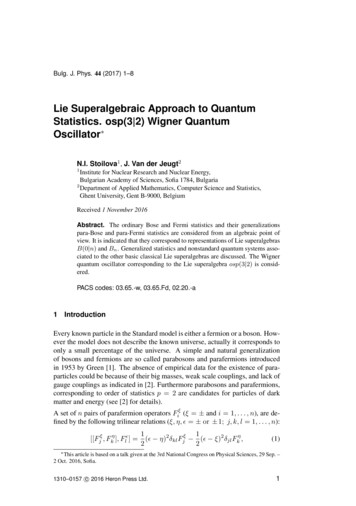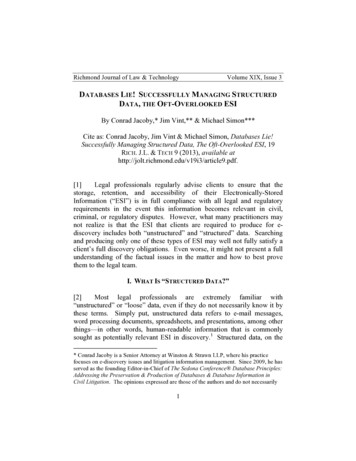
Transcription
Richmond Journal of Law & TechnologyVolume XIX, Issue 3DATABASES LIE! SUCCESSFULLY MANAGING STRUCTUREDDATA, THE OFT-OVERLOOKED ESIBy Conrad Jacoby,* Jim Vint,** & Michael Simon***Cite as: Conrad Jacoby, Jim Vint & Michael Simon, Databases Lie!Successfully Managing Structured Data, The Oft-Overlooked ESI, 19RICH. J.L. & TECH 9 (2013), available egal professionals regularly advise clients to ensure that thestorage, retention, and accessibility of their Electronically-StoredInformation (“ESI”) is in full compliance with all legal and regulatoryrequirements in the event this information becomes relevant in civil,criminal, or regulatory disputes. However, what many practitioners maynot realize is that the ESI that clients are required to produce for ediscovery includes both “unstructured” and “structured” data. Searchingand producing only one of these types of ESI may well not fully satisfy aclient’s full discovery obligations. Even worse, it might not present a fullunderstanding of the factual issues in the matter and how to best provethem to the legal team.I. WHAT IS “STRUCTURED DATA?”[2]Most legal professionals are extremely familiar with“unstructured” or “loose” data, even if they do not necessarily know it bythese terms. Simply put, unstructured data refers to e-mail messages,word processing documents, spreadsheets, and presentations, among otherthings—in other words, human-readable information that is commonlysought as potentially relevant ESI in discovery.1 Structured data, on the* Conrad Jacoby is a Senior Attorney at Winston & Strawn LLP, where his practicefocuses on e-discovery issues and litigation information management. Since 2009, he hasserved as the founding Editor-in-Chief of The Sedona Conference Database Principles:Addressing the Preservation & Production of Databases & Database Information inCivil Litigation. The opinions expressed are those of the authors and do not necessarily1
Richmond Journal of Law & TechnologyVolume XIX, Issue 3other hand, refers to information residing in electronic repositories orsilos, such as transactional and financial databases.2 Unlike unstructureddata, which typically exists as static and self-contained files that arepreserved, collected, processed, reviewed, authenticated, and admitted intoevidence as stand alone documents, structured data exists as segments ofinformation inside a larger system, one that is often quite complex andcontains many parts.3 A database record, the closest analog that structureddata has to a “document,” may not actually exist until a user performssome action through the database system to assemble a number of separatefields that could reside in many different parts of the system. For thisreason, information stored in a database cannot be placed into a standarde-discovery review system that has been optimized to view and categorizeunstructured data.reflect the views of their respective firms or clients. This article is for general informationpurposes and is not intended to be and should not be taken as legal advice** Jim Vint is a Managing Director at Navigant Consulting, Inc. and runs the StructuredData and Development team within the Technology Solutions group. He focuses ondiscovery and disclosure of non-traditional ESI data sources including structureddatabases. His clients include global organizations facing regulatory investigations, crossborder discovery issues, and general commercial disputes.*** Michael Simon is Director of Strategic Development for Navigant Consulting,Inc. Michael, a former practicing attorney, has worked with and counseled clientsregarding e-discovery issues and best practices for over a decade. He frequently lectureson e-discovery, legal technology and Internet law in venues across the United States,including Tufts University, where he has taught as a visiting lecturer.1See THE SEDONA CONFERENCE , THE SEDONA CONFERENCE GLOSSARY: EDISCOVERY AND INFORMATION MANAGEMENT 52 (Sherry B. Harris ed., 3d ed. 2010)[hereinafter Sedona Glossary].2See id. at 49.3See id. at 13, 49, 52 (definitions of “database,” “database management system,”“structured data,” and “unstructured data”).2
Richmond Journal of Law & TechnologyVolume XIX, Issue 3[3]The ESI stored in databases and other structured data repositoriesis every bit as relevant and discoverable as the loose files that are morecommonly requested. Federal Rule of Civil Procedure (“FRCP”) 34 isclear and unambiguous on this point:Rule 34. Producing Documents, Electronically StoredInformation, and Tangible Things, or Entering onto Land,for Inspection and Other Purposes(a) In General. A party may serve on any other party arequest within the scope of Rule 26(b):(1) to produce and permit the requesting party or itsrepresentative to inspect, copy, test, or sample thefollowing items in the responding party's possession,custody, or control:(A) any designated documents ngs, drawings, graphs, charts, photographs,sound recordings, images, and other data or datacompilations—stored in any medium from whichinformation can be obtained either directly or, ifnecessary, after translation by the responding partyinto a reasonably usable form[.]4[4]Unlike the discovery of unstructured data, for which a number ofbest practices have emerged, it has been difficult for the legal industry todevelop best practices for the treatment of structured data in civildiscovery due to the vast diversity of size, scope, and features found indifferent database systems. The Sedona Conference , a non-partisan legalthink-tank founded in 1997, formed a group in early 2009 to study theissues surrounding the discovery of structured data—culminating in thepublication of The Sedona Conference Database Principles Addressingthe Preservation and Production of Databases and Database Informationin Civil Litigation (hereinafter the “Sedona Database Principles”) in April4FED. R. CIV. P. 34(a)(1)(A) (emphasis added).3
Richmond Journal of Law & TechnologyVolume XIX, Issue 32011. 5 The Sedona Database Principles expand upon the originalpublication, The Sedona Principles: Best Practices Recommendations &Principles for Addressing Electronic Document Production (hereinafterthe “Sedona Principles”),6 as they specifically apply to databases and setout six additional precepts that provide practical suggestions forsimplifying the discovery of structured data and clarifying the obligationsof both the requesting and producing parties.7 An overarching theme ofthe Sedona Database Principles is that better communication betweenparties, their legal advisors and agents, and information technologyprofessionals will substantially improve the management of this type ofspecialized ESI in legal disputes.8 To that end, the Sedona DatabasePrinciples specifically reference many of the precepts of the SedonaPrinciples that address and encourage cooperation between the parties.9II. HOW DOES STRUCTURED DATA BECOME RELEVANT?[5]Databases frequently record historical transactions and informationthat is relevant in litigation and investigations. One would certainlyexpect that enterprise-level systems like Oracle and SAP, not to mentionfinancial and transactional systems, human resource tracking systems, datawarehouses, and content management systems (“CRM”), would allcontain structured data. However, other commonly used systems,5See THE SEDONA CONFERENCE , THE SEDONA CONFERENCE DATABASE PRINCIPLES:ADDRESSING THE PRESERVATION & PRODUCTION OF DATABASES & DATABASEINFORMATION IN CIVIL LITIGATION 21 (Conrad J. Jacoby et al. eds., 2011) [hereinafterSedona Database Principles].6See THE SEDONA CONFERENCE , THE SEDONA PRINCIPLES: BEST PRACTICESRECOMMENDATIONS & PRINCIPLES FOR ADDRESSING ELECTRONIC DOCUMENTPRODUCTION 30 (Jonathan M. Redgrave et. al ed., 2d eds. 2007) [hereinafter SedonaPrinciples].7See Sedona Database Principles, supra note 5, at ii, 8.8See id. at ii.9See id at ii, 8-9.4
Richmond Journal of Law & TechnologyVolume XIX, Issue 3including Cloud-based “Software-As-A-Service” (“SaaS”) systems, alsofeature the same back-end structured data systems as more obvious“database” systems. Thus, structured data has largely replaced loosedocuments for tracking information for these and other similar functions:accident/incident reporting systems, call center records and associated dataanalytics, world wide web servers, point of sale systems, and social media.[6]The cumulative volume of data in business-related structured datarepositories is immense and is projected to grow at an estimated annualrate of nearly twenty percent. 10 Perhaps even more important to ediscovery practitioners, a recent survey about the state of discovery in civillitigation has shown that e-mail, the central focus of e-discovery requestsfor over fifteen years, is no longer the leading requested item.11 Instead,database and application data are now more often requested.12[7]An increasing number of litigation disputes involving “highprofile” companies have made demands upon litigants to review, disclose,and produce at least portions of their databases. Several examples areexplored below.[8]The plaintiffs in In re eBay Seller Antitrust Litigation, an antitrustclass action, sought production of transactional data from defendanteBay.13 The court granted the motion in part and eBay objected, claimingthat the information sought did not already exist in easily compiled form,10Nexsan Corp., Registration Statement (Form S-1), at 61 (Jan. 25, 2011), available 00104746911000283/a2200385zex99 2.htm.11See Information Retention and eDiscovery Survey Global Findings, SYMANTEC 1, per/InfoRetention eDiscovery Survey Report cta54646.pdf.12Id.13In re eBay Seller Antitrust Litig., No. C 07-1882 JF (RS), 2009 WL 3613511, at *1(N.D. Cal. Oct. 28, 2009).5
Richmond Journal of Law & TechnologyVolume XIX, Issue 3requiring eBay “to spend hundreds of thousands of dollars to dedicate ahighly specialized engineering resource for a period of more than sixmonths to create new data” solely for the matter.14 However, eBay’s ownsubmissions in support of the objection contained three different estimates,ranging from a low of 179,000 to a high of 300,000.15 Moreover,eBay’s employee in charge of data warehouse development declared thatthe provided estimate could vary “by as much as five hundred percent.”16The court first disposed of eBay’s argument that it could not be required tocreate anything new, finding that FRCP 34(a)(1)(A) supported themagistrate’s finding that the technical burden of creating the new materialdid not excuse production.17 In light of the hundreds of millions of dollarsat stake in the action involving a defendant with billions of dollars inannual gross profits, and considering that the magistrate had alreadyscaled back the scope of discovery, the court found no clear error in themagistrate’s determination that the potential costs and technicalrequirements were not unduly burdensome.18[9]In another case, a plaintiff injured by a sink that fell from a highstoreroom shelf sought production of the database that the defendant,Lowe’s, used to record and track accident and injury claims.19 The trialcourt ordered Lowe’s to present a witness with knowledge and access tothe system and to print out all requests for accidents occurring before thedate of the plaintiff’s injury.20 Notably, Lowe’s objected that: (1) it hadalready produced a printout from the database of all falling merchandise14Id.15Id. at *2.16Id.17See id.18See In re eBay Seller Antitrust Litig., 2009 WL 3613511, at *3.19In re Lowe's Cos., 134 S.W.3d 876, 877 (Tex. App. 2004).20See id. at 877.6
Richmond Journal of Law & TechnologyVolume XIX, Issue 3claims for its stores within the state for the last five years; (2) theremaining portions of the database were not relevant; (3) the manner inwhich accident information was gathered and stored was a trade secret; (4)the purpose of the database was not for safety-related information; and (5)there was no way to restrict production of privileged or non-relevantinformation.21 The appellate court agreed with Lowe’s in part and limitedthe plaintiffs from accessing data without limitation as to time, place, orsubject matter.22[10] In Procter & Gamble v. Haugen a plaintiff appealed from thedismissal of his Lanham Act and tortious interference claims whichresulted in part from the court sanctioning it for failing to preserverelevant database information.23 Procter & Gamble (“P&G”) claimed thatagents of a competitor spread false rumors that the company supportedSatanism, using the profits from forty-three products to do so.24 P&G andits expert witnesses used the services of a third party vendor, InformationResources Incorporated (“IRI”), to track potential lost sales of the fortythree involved products.25 IRI used a database that gathered purchaseinformation from retail stores into electronic market share databases.26IRI’s databases stored data on a “rolling” basis so that data was kept onlyfor a period of time before it was deleted from the system to make roomfor more data.27 Defendants requested production of all of the informationthat P&G used from the IRI databases and when P&G was unable toproduce all of this information, the court found that P&G had spoliated the21Id. at 878.22See id. at 880.23Procter & Gamble Co. v. Haugen, 427 F.3d 727, 730, 732-37 (10th Cir. 2005).24Id. at 731.25Id. at 731-32.26Id. at 731.27Id.7
Richmond Journal of Law & TechnologyVolume XIX, Issue 3data and dismissed the matter as a sanction.28 On appeal, P&G focused onthe fact that it was only a subscriber to the IRI database, did not own orcontrol the system, and therefore could not have practicably provided theinformation to defendants.29 P&G could have provided direct access tothe system to defendants, but this would not have covered all of theinformation they sought.30 P&G would have had to pay over thirty milliondollars to obtain all of the information from IRI and even if it had, itwould not have had sufficient storage capacity for the data.31 The court ofappeals found that the district court had failed to address the fact that P&Gdid not “possess” the data and along with the defendants’ failure to proveprejudice, reversed the sanctions order.32[11] In another case involving a Lanham Act claim, a plaintiff soughtdiscovery about the defendants’ sales of an alleged infringing product. 33One of those defendants, Wal-Mart, responded with 1,771 pages of Batesstamped documents that represented a print-out of the tabular view of theraw data within its sales database.34 Plaintiff claimed that the printouts,with line item data arranged by columns and UPC codes, was“indecipherable” and thereby an insufficient response.35 The court was28See Procter & Gamble Co., 427 F.3d at 732-33, 735-37.29See id. at 739.30See id.31See id. In 2013, it may seem unbelievable that a major corporation, like P&G would beunable to afford sufficient storage capacity for this data. However, when this case wasdecided in 1995, the court recognized 30 million as a prohibitive storage cost. See id.32Id. at 739-41.33See Powerhouse Marks, L.L.C. v. Chi Hsin Impex, Inc., No. Civ.A.04CV73923DT,2006 WL 83477, at *1-2 (E.D. Mich. Jan. 12, 2006).34See id. at *1, *3.35Id. at *3.8
Richmond Journal of Law & TechnologyVolume XIX, Issue 3“convinced” that Wal-Mart’s burden in deriving the information from thedatabase was “significantly less” than on the plaintiff since Wal-Martcontrolled the system.36 For this reason, the court granted plaintiff’smotion to compel a more sufficient response from Wal-Mart.37[12] Finally, in an Americans with Disabilities Act claim, the EqualEmployment Opportunity Commission (“EEOC”) sought to compelproduction of portions of the human resources database of a Supervalu andJewel-Osco, major national food retailers.38 The EEOC originally soughtbroad production of information from the human resources database, butnarrowed its requests after a meet and confer session to employee hiring,transfer, and termination records, along with job postings for the subjecttime period.39 The EEOC premised its request on the defendants’ ownFRCP 30(b)(6) testimony that “this sort of analysis could be completed”and that defendants’ “types of database are designed for this sort ofproduction at minimal expense.”40 Defendants first claimed that they didnot have the particular database tool activated in their system to allowthem to provide the information requested by the EEOC.41 Defendantsthen objected to the scope and burden of the request, claiming that theinformation would cover over 180 locations and 100,000 employees(when there were only 108 claimants) and that it would take their ITpersonnel over a week to write the code necessary to obtain the data.42The court found that the EEOC had not established that the relevance or36Id.37See id. at *4.38EEOC v. Supervalu, Inc., No. 09 CV 5637, 2010 WL 5071196, at *1 (N.D. Ill. Dec. 7,2010).39Id. at *6-7.40Id. at *6.41Id. at *7.42Id.9
Richmond Journal of Law & TechnologyVolume XIX, Issue 3benefit of the information outweighed the burden and expense ofproducing it and thus denied the motion to compel.43III. CAN A PARTY WAIT TO DEAL WITH STRUCTURED DATA UNTIL THATINFORMATION HAS BEEN REQUESTED?[13] The information contained in databases can make the differencebetween winning and losing a case. The Sedona Database Principlesmakes this statement as a matter of plain fact: “Information contained indatabases may be the best source for establishing certain facts in a legaldispute. Information stored in this format also may be useful, if notessential, for analyses such as sorting, calculating, and linking to answerquantitative questions presented in a case.”44[14] It is a simple matter to move from the abstract language of theSedona Database Principles to concrete situations. Unstructured data,particularly e-mail, instant messages (“IM”), and typical “office”documents (i.e., Microsoft Word, Excel, and PowerPoint) providesevidence of the communication of activities—who knew what and when.People will write e-mail and text messages to others concerning what theydid. Similarly, they will draft documents to memorialize actions that theyhave taken. In contrast, the structured data in transactional and financialdatabases provides direct evidence of the action—how, how much, andhow often. The financial system will show that money was moved and thetime and accounts involved. A transactional application will record thesupervisor’s approval of the money transfer. Thus, the database systemsprovide a way to “follow the money” and recreate what happened, even ifthe communications record is incomplete or, in the case of fraud or shadydealing, deliberately obscured. For this reason, some have called43Supervalu, Inc., 2010 WL 5071196, at *8, *12.44Sedona Database Principles, supra note 5, at 4.10
Richmond Journal of Law & TechnologyVolume XIX, Issue 3structured data “forgotten data”—“perhaps the single biggest missedopportunity for defense in e-discovery.”45IV. PLANNING FOR DISCOVERY OF STRUCTURED DATA[15] Databases, especially major, enterprise, or department-levelsystems, are often highly complex and highly customized. The discoveryof structured data typically requires specific expertise with experience indeciphering data structures, relationships, and connections to othersystems. The Sedona Database Principles is filled with warnings aboutthe need for expert assistance,46 and it likens the act of trying to handlediscovery requests involving structured data without such knowledge as“akin to seeing a thousand-piece jigsaw puzzle without an illustration thatshows the final completed puzzle.”47[16] Seeking information stored in structured data repositories alsorequires more planning—and often more efforts at cooperation betweenthe parties—than traditional e-discovery. Parties that do not meet andconfer before commencing structured data requests may well find that thecourt sends them back to square one. 48 Many reasons exist for this45Courtney Fletcher & Liam Ferguson, E-Discovery: Remembering Forgotten Data,WALL STREET & TECH. (Oct. 21, 2009), 32.46See Sedona Database Principles, supra note 5, at 2, 6, 12, 17; see also DouglasHerman, Digital Investigations – Where You Forgot To Look: Why Databases Often AreOverlooked When It Comes Time To Harvest Electronic Data, METRO. CORP. COUNS.,(Aug. 2006), .pdf (“To extractdata from a relational structure[,] such as a CRM or ERP database, requires specificexpertise and a solid understanding of the underlying bases of how these databaseswork.”).47Sedona Database Principles, supra note 5, at 2.48See Rebman v. Follet Higher Educ. Grp., Inc., No. 6:06-CV-1476-ORL-28KRS, 2007WL 1303031, at *3 (M.D. Fla. May 3, 2007) (Plaintiff’s broad request for data from adatabase with over 200 million records denied by the court as overbroad; court ordered11
Richmond Journal of Law & TechnologyVolume XIX, Issue 3heightened need for additional proactive planning and discussion, but nonemay be more pressing than the fact that downstream productionrequirements will control the early stage EDRM work conducted inPreservation, Collection, and Processing, and even potentially as far backas the critical Identification phase of e-discovery.[17] It should come as no surprise that the Sedona Database Principlesplaces particular emphasis on one of the core principles from the originalSedona Principles:Sedona Principle 3: The Early “Meet and Confer”“Parties should confer early in discovery regarding thepreservation and production of electronically storedinformation when these matters are at issue in the litigationand seek to agree on the scope of each party’s rights andresponsibilities.”Sedona Principle 3 is especially applicable in thecontext of database discovery because of thecomplicated technical and logistical questionsraised by the storage of information in databases.Database discovery may entail some of the mostexpensive and complex discovery in a litigationmatter, and meaningful conversations between theparties early in the litigation can substantiallyreduce confusion and waste of resources.49[18] Challenges to the discovery of information stored in structureddata repositories can occur from both opposing parties and litigants. Manyparties to meet and confer under Rule 26(f) to narrow the request and determine the needversus the burden on the defendant).49Sedona Database Principles, supra note 5, at 8 (quoting Sedona Principles, supra note6, at 21).12
Richmond Journal of Law & TechnologyVolume XIX, Issue 3of the solutions for best using data from databases require the creation of anew view or analysis that differs from the way that the information is usedin the ordinary course of business. Responding to structured data requestsis likely to require new reports, new extracts directly from the systems, oreven entirely new systems to analyze data. Attorneys are often notcomfortable with this process, especially since information about howthese new views of structured data were created may have to be disclosedto the other side if challenges arise as to the adequacy of the proffereddiscovery response. Thus, it is critical to complete a full and frankdiscussion, between all stakeholders—each side and each role (Legal, IT,outside expert)—that clearly sets out all expectations before any workbegins.[19] The first issue that practitioners are likely to confront during the ediscovery process involves the specific elements that will be extractedfrom the database. In some situations, it may be necessary to preserve andcollect elements that would not normally be considered “content,” such asreports, formulas, pick lists, reports, queries, and the like.50 For example,FLSA class action litigation often revolves around issues of howcompanies determined which employees were exempt from overtime andwhich were non-exempt; formulas within the HR and payroll systemsapplying these standards become critical.51 Fraud cases that center aroundwho knew what and when could require the recreation of standard reportsand views that were used at the time of the alleged suspicious activity.5250See id. at 24.51See, e.g., Ojeda-Sanchez v. Bland Farms, LLC, No. CV608-096, 2009 WL 2365976, at*3 (S.D. Ga. July 31, 2009) (requiring production of entire database as “metadata” wherethe formulas within the system were relevant to the issues in a wage and hour classaction); see also Sedona Database Principles, supra note 5, at 25 illus. iii.52See, e.g., Goshawk Dedicated Ltd. v. Am. Viatical Servs., LLC, No. 1:05CV2343RWS, 2007 WL 3492762, at *1 (N.D. Ga. Nov. 5, 2007) (requiring production ofdatabase in fraud and truth in lending case required despite respondent’s claim that it wasconfidential and “the single greatest asset” of the party because the accuracy of the dataand algorithms therein was highly relevant to the claims and defenses of the case).13
Richmond Journal of Law & TechnologyVolume XIX, Issue 3Such elements will almost certainly require rigorous preservation andcollection methods, such as a complete database copy or a restored fullback up, as outlined below.[20] In most cases, practitioners will need to focus solely on databasecontent: the fields and records. With this approach, legal teams mustanticipate potential issues as they either use or produce this information.Concerns include: (1) a need for completeness and usability of the dataset; (2) availability of the data and technical feasibility of any plannedsearch and retrieval Methods; and (3) cost. Each concern is explored inturn below.A. A Need for Completeness and Usability of the Data Set[21] The fact that some of the data within a database may be relevantdoes not mean that the entire database must be produced. SedonaDatabase Principle 1: Scope of Discovery clearly speaks to this point:“Absent a specific showing of need or relevance, a requesting party isentitled only to database fields that contain relevant information, not theentire database in which the information resides or the underlying databaseapplication or database engine.”53[22] Will legal teams require a complete set of data or merely anextensive subset of potentially relevant records? For a small subset ofdata, a surgical approach will likely suffice. However, if a completedataset will be required for further analysis, the scope of databasepreservation, collection, and production will be much more extensive.Date ranges for activity or database information creation may be helpful atthis stage.[23] Does the team require a picture of the information present at aparticular point in time? If so, a snapshot of the data or the system willlikely accomplish these objectives. To create a historical record, a trend53Sedona Database Principles, supra note 5, at 21.14
Richmond Journal of Law & TechnologyVolume XIX, Issue 3line, or to illustrate changes over time, more comprehensive preservationand collection will be required.B. Availability of the Data and Technical Feasibility of anyPlanned Search and Retrieval Methods[24] Structured data systems have a variety of capabilities and technicalcapacity. Many of the older legacy systems can be very limited in howone can manipulate and export data. Thus, before making any plans—orworse, commit to a regulator or the other side in litigation as to amethodology or deliverable data—it is critical to determine whether thetarget system includes the necessary capabilities. The answer to thisquestion will vary by the circumstances of each case, but some of thequestions highlighted in Comment 2B of the Sedona DatabasePrinciples54 provide a good starting point: Can a user run searches within the system, other than those builtspecifically for the intended business uses of the database?55 Will the searches bring back complete information (i.e., all therequested data)?5654See id. at 27-30.55See id. at 28. The problem of database systems designed for particular purposes, whichare not accessible in the ways required for discovery, was specifically recognized by theStanding Committee of the Judicial Conference in its September 2005 ReportRecommending the Adoption of the 2006 Amendments, as a potential form or not“readily accessible” ESI under Rule 26(b): “[D]atabases that were designed to createcertain information in certain ways and that cannot readily create very different kinds orforms of information.” REPORT OF JUDICIAL CONFERENCE OF THE UNITED STATES ONRULES OF PRACTICE AND PROCEDURE C-42 (Sept. 2005), available s/rules/Reports/ST09-2005.pdf[hereinafter Judicial Conference Report].56To optimize database performance, some database systems will only index portions oflong, free-form text fields—such as the first few hundred characters—so that searchresults from such systems may not be complete. See Sedona Database Principles, supranote 5, at 17, 28.15
Richmond Journal of Law & TechnologyVolume XIX, Issue 3 Is there information stored outside of fielded tables?57 Does the producing party have custody and control of the database,such that it can access the “back end” of the system to export data,create custom reports, or otherwise access the system outside ofnormal business use?58 Does the system support third party tools that might be moreefficient at querying the data?59 Does the system have reporting capabilities?60 Does the system support the creation of custom reports?[25] The answers to these and other questions will directly impact theextent to which a case team can preserve, collect, and ultimately producethe data stored within a database system. It is crucial that qualifie
Richmond Journal of Law & Technology Volume XIX, Issue 3 !! 4 2011.5 The Sedona Database Principles expand upon the original publication, The Sedona Principles: Best Practices Recommendations & Principles for Addressing Electronic Document Production (hereinafter the "Sedona Principles"),6 as they specifically apply to databases and set

